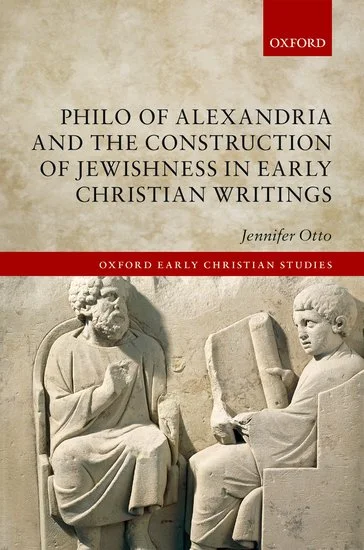Jennifer Otto, Philo of Alexandria and the Construction of Jewishness in Early Christian Writings. Oxford University Press, 2018.
At its core, Jennifer Otto’s revised dissertation is a study of “third terms”: Pythagorean, predecessor, and Hebrew. These are the key epithets that fill in the blank following the introduction of “Philo the __________” in the writings of Clement of Alexandria, Origen, and Eusebius, respectively.
As Otto rightly observes, scholars have recognized for quite some time our modern indebtedness to ancient Christian authors for preserving the works of Philo, yet the transmission of Philonic traditions were of course never neutral enterprises. Like Josephus, Philo was particularly useful for early Christians, especially as they reckoned with what they eventually termed the Old Testament. Philo’s propensity toward allegorical exegesis made him a popular source for Christians who sought ways around many of the legal requirements of the law in order to carve out an identity that was distinct from their Jewish contemporaries, yet related to the Jewish scriptures they had claimed as their own.
Previous scholarship on early Christian uses of Philo has largely emphasized them as rather straightforward cases of “adoption” or rhetorical “baptism” culminating in “Philo Christianus” traditions that include legends such as his friendship with Peter when he came to Rome for his embassy with Gaius, his baptism by the apostle John, and even his ordination to the office of bishop. To the contrary, Otto maintains that by paying attention to the third terms, especially among the earliest Christian readers of Philo, we discover something a bit more complicated than mere adoption or baptism. She argues instead that the earliest invocations of Philo are best understood in the context of “ongoing efforts by Christians to conceptualize and demarcate the difference between two emerging but fluid collective identities, ‘Christianness’ and ‘Jewishness’” (4).
After laying the groundwork for the study Otto begins with a discussion of how Christians came to gain access to Philo’s writings in the first place, arguing against the grain of traditional scholarship that has long assumed transmission through “Jewish-Christian” circles. She argues instead for the likelihood of Pythagorean-Platonic philosophical schools, which may provide important clues for how these early Christians understood Philo and why—somewhat strangely—they never refer to him as “Philo the Alexandrian Jew.” She proposes that Philo’s works found their way into Alexandrian philosophical circles as an example of “barbarian philosophy” and eventually “were exchanged by members of the learned elite in Alexandria and Rome” (47). According to Otto, it was precisely this exchange that facilitated the earliest Christian encounters with Philo’s works.
In chapter two, Otto examines Clement of Alexandria’s invocation of Philo in the Stromateis, noting the somewhat strange phenomenon of referring to Philo as “the Pythagoarean.” Perhaps even more interestingly, Clement typically speaks very highly of Pythagoreans and suggests no essential distinction between them and Christians in matters of ethics. The only criticism he levies against Pythagoreans is against the doctrine of the transmigration of the soul and related vegetarianism. Thus, Otto argues, “Clement constructs an identity for Philo that blurs the opposition between Hebrew and Greek wisdom, an opposition that Clement seeks to deconstruct throughout the Stromateis” (89). Such categorical obfuscation demonstrates larger trends in how Christians often used Philo as well as the striking ambivalence with which he tended to be treated.
Origen’s construction of Philo regards him as “one of our predecessors.” Direct references to Philo are unfortunately sparse in Origen’s work—only three times, to be precise—yet Otto’s analysis is of those three occasions is refreshingly fruitful. She does so primarily by parsing out the discrete features of terms like Ioudaios, Hebraios, and Israel in Origen and how Philo fits into Origen’s taxonomy. Her analysis reveals a fundamental ambivalence Origen shows toward Philo, referring to him positively in some instances and connecting him to other Hebraioi as a predecessor in allegorical exegesis, while also rejecting or ignoring other key parts of Philo’s exegesis that would more closely align him with Origen’s contemporary Ioudaioi. Origen’s use of Philo is therefore selective and ambivalent, relying on him for allegorical readings of etymologies and biblical narratives, while rejecting his legal expositions.
The final “third word” Otto studies is Eusebius’ construction of “Hebrew,” with which he identifies Philo. Eusebius uses Philo in numerous contexts, which has contributed to inconsistent scholarly evaluations of Philo in Eusebius, with some referring to Philo as a “virtual Christian” (153), and others accentuating Eusebius’ insistence on Philo’s Jewishness. Otto therefore offers a rather thorough analysis of his Philo’s various deployments throughout Eusebius’s writings. He clearly aligns Philo with his venerated Hebraioi, yet, Otto observes, Philo is at his most “Hebrew” when he is espousing ideas approved by Plato” (193). Once again, what we see is the strategic deployment for particular rhetorical ends as he constructs the categories Hebraioi and Ioudaioi. Thus Otto is able to demonstrate the discursive contours of boundary construction in Eusebius and how he uses Philo to construct categories for his own contemporaneous debates about identity.
In the end, Otto’s study should be appreciated for her keen eye on how Philo occupies an in-between space, mediating the categories of Christian and Jew for later Christian readers. The epithets he is given betray at once the utility and liability of Philo for Christian discourses of identity because of how he is depicted as never fully one of “us” nor one of “them.” By drawing attention to the epithets and how they are variously deployed she is able to make critical insights on the active work that goes into manufacturing identities and how perceived differences are either highlighted, collapsed, or otherwise dealt with. Otto’s study is a useful analysis of, in the words of J.Z. Smith (to whom she has frequent recourse), “what a difference a difference makes.”[1]
Sheldon Steen is a PhD candidate in Religions of Western Antiquity at Florida State University.
[1] Jonathan Z. Smith, “What a Difference a Difference Makes,” in Relating Religion: Essays in the Study of Religion (Chicago: University of Chicago Press, 2004), 251-302.
